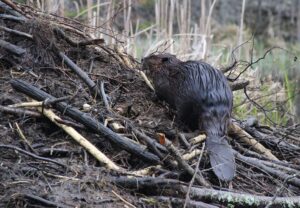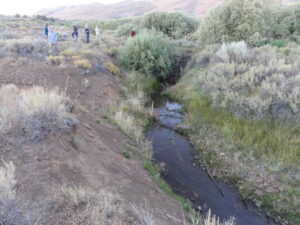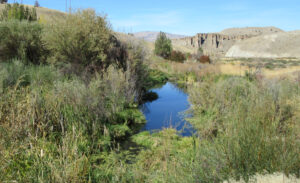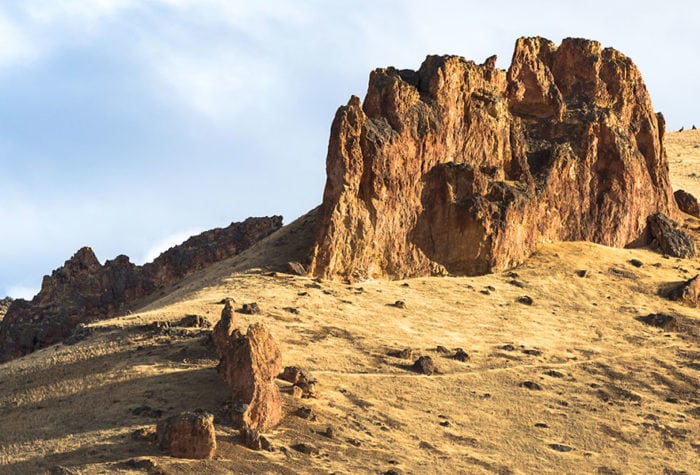Author: Renee Schiavone | Published: January 17, 2024 | Category: Species Spotlight
This article originally appeared in The Source on February 14, 2024.
What we can learn from beaver about keeping desert waterways healthy
In late fall, while pronghorn prepare for winter migration and sagebrush lizards enter hibernation, beavers are hard at work. They’re ferrying across waterways, cutting down streamside trees with their teeth and submerging their stock into shallow water. Neither hibernators nor migrators, they’ll subsist off this wet pantry of live wood and green bark until spring comes around, bringing seasonal fresh grass and flowering plants to round out their vegetarian diets.

Beavers are inextricably linked to a life in water – an attribute that is essential for both their productivity and survival. With a majority of the species’ predators existing on land, beavers have adapted to live in waterways. Webbed hind feet and broad, flat, paddle-shaped tales are conducive to swimming, while two sets of lips are specially evolved to seal shut around their characteristic big front teeth, allowing them to gnaw on plants and trees while underwater without drowning.
Perhaps most recognizable by their homes, beavers are known for building dams. Unbeknownst to many, these dams serve many purposes. With tree food to harvest and land-dwelling predators to avoid, beavers use dam-building as a strategy to move water. Flooding sections of river and stream, dams raise water levels to give beavers safer access to tasty trees. In the process of building dams across waterways, beavers create ponds behind them – a safe space to situate underwater entrances to their lodges.
But what’s earned the American beaver the nickname “nature’s ecosystem engineers” is the work they do to shape their environment.

Oregon is nearly always facing drought or its lingering conditions. Livelihoods in Oregon’s high desert rely on having water in streams during the growing season – which inconveniently coincides with the driest time of year. In many cases, when spring snow melts and water rushes down through eastern Oregon creeks, the water is gone before agricultural season even starts. However, even in the dry climate of eastern Oregon, in streams with what seems like only seasonal flows, beavers can change things dramatically. By putting up their dams, beavers recharge the water table, benefitting streamside landscapes and fostering life. These beaver-dammed streams and rivers store water that is soaked into the surrounding ground, measuring acres and tens of millions of gallons. This aids in establishing wetlands and meadow-like habitat, as well as helping sequester carbon from the atmosphere. Meanwhile, beaver ponds – the still, above-ground water behind dams – establish important habitat for many species of fish, birds and other wildlife who need this source of water to survive. Overall, this natural water storage method increases vegetation growth and resilience, supporting a diverse array of desert life – a direct result of beavers inhabiting the landscape.
Beaver dams show the species’ abilities to manage water on a localized scale. But can their management methods also make a meaningful difference on a large scale?
Oregon Natural Desert Association – the Bend-based nonprofit focused on desert conservation – pays close attention to the health of desert rivers and streams, as they’re the lifeblood of Oregon’s high desert. With changing desert climates bringing less rain, warmer temperatures and stronger storms, sustaining cool, clear and enduring waters is essential to supporting thriving populations of fish, wildlife and people. From planting trees along stream banks to building in-stream structures that mimic beaver dams, ONDA is following a thoughtful restoration approach guided by the work of nature’s ecosystem engineers.

So far, it’s been successful. In a recently completed project on the South Fork Crooked River, ONDA sought to reestablish large vegetation areas along desert waterways that have been absent in the area for over a hundred years, subsequently restoring enough suitable habitat for beavers to recolonize the watershed and resume their role as ecosystem stabilizers. If given enough water, food and space, beavers can re-engineer the missing habitat that hundreds of native species (including humans) depend upon, holding it all together as a keystone species.
With the help of volunteers, over the past decade ONDA has planted tens of thousands of trees and constructed dozens of beaver dam analogues to support them. Through this project, the organization innovated deep planting methods that resulted in remarkably high survival for newly planted trees, and ultimately increased plant growth by up to 400%. As these plants mature into a diverse stream-side forest, they will provide many habitat benefits, including shading the stream water, increasing habitat quality and diversity for fish and wildlife, and providing food for growing colonies of beaver.
There’s a lot we can learn from this species. For starters, what we do shapes our environment. If you’re looking to get involved in shaping Oregon’s environment for the better, consider creating beaver habitat and improving wildlife habitat throughout the region by taking part in an upcoming restoration project. You might just find yourself becoming a beaver believer.
—Renee Schiavone is the Communications Manager at Oregon Natural Desert Association, a nonprofit that protects and restores Oregon’s high desert public lands and waters. Read more of her work at onda.org/author/rschiavone.

